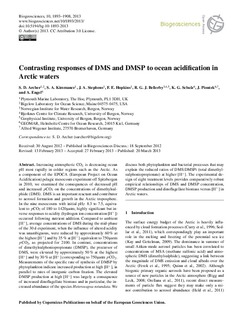| dc.contributor.author | Archer, S.D. | |
| dc.contributor.author | Kimmance, S.A. | |
| dc.contributor.author | Stephens, J.A. | |
| dc.contributor.author | Hopkins, F.E. | |
| dc.contributor.author | Bellerby, Richard | |
| dc.contributor.author | Schulz, K.G. | |
| dc.contributor.author | Piontek, J. | |
| dc.contributor.author | Engel, A. | |
| dc.date.accessioned | 2014-02-27T09:35:21Z | |
| dc.date.accessioned | 2014-04-12T10:49:54Z | |
| dc.date.available | 2014-02-27T09:35:21Z | |
| dc.date.available | 2014-04-12T10:49:54Z | |
| dc.date.issued | 2013 | |
| dc.identifier.citation | Archer, S.D., Kimmance, S.A., Stephens et al. 2013. Contrasting responses of DMS and DMSP to ocean acidification in Arctic waters. Biogeosciences 10(3) 1893-1908. doi:10.5194/bg-10-1893-2013 | nb_NO |
| dc.identifier.issn | 1726-4170 | |
| dc.identifier.uri | http://hdl.handle.net/11250/194288 | |
| dc.description.abstract | Increasing atmospheric CO2 is decreasing ocean pH most rapidly in colder regions such as the Arctic. As a component of the EPOCA (European Project on Ocean Acidification) pelagic mesocosm experiment off Spitzbergen in 2010, we examined the consequences of decreased pH and increased pCO2 on the concentrations of dimethylsulphide (DMS). DMS is an important reactant and contributor to aerosol formation and growth in the Arctic troposphere. In the nine mesocosms with initial pHT 8.3 to 7.5, equivalent to pCO2 of 180 to 1420 μatm, highly significant but inverse responses to acidity (hydrogen ion concentration [H+]) occurred following nutrient addition. Compared to ambient [H+], average concentrations of DMS during the mid-phase of the 30 d experiment, when the influence of altered acidity was unambiguous, were reduced by approximately 60% at the highest [H+] and by 35% at [H+] equivalent to 750 μatm pCO2, as projected for 2100. In contrast, concentrations of dimethylsulphoniopropionate (DMSP), the precursor of DMS, were elevated by approximately 50% at the highest [H+] and by 30% at [H+] corresponding to 750 μatm pCO2. Measurements of the specific rate of synthesis of DMSP by phytoplankton indicate increased production at high [H+], in parallel to rates of inorganic carbon fixation. The elevated DMSP production at high [H+] was largely a consequence of increased dinoflagellate biomass and in particular, the increased abundance of the species Heterocapsa rotundata. We discuss both phytoplankton and bacterial processes that may explain the reduced ratios of DMS:DMSPt (total dimethylsulphoniopropionate) at higher [H+]. The experimental design of eight treatment levels provides comparatively robust empirical relationships of DMS and DMSP concentration, DMSP production and dinoflagellate biomass versus [H+] in Arctic waters | nb_NO |
| dc.language.iso | eng | nb_NO |
| dc.publisher | European Geosciences Union | nb_NO |
| dc.relation.uri | http://www.biogeosciences.net/10/1893/2013/bg-10-1893-2013.html | |
| dc.rights.uri | https://creativecommons.org/licenses/by/3.0/ | |
| dc.title | Contrasting responses of DMS and DMSP to ocean acidification in Arctic waters | nb_NO |
| dc.type | Journal article | nb_NO |
| dc.type | Peer reviewed | |
| dc.date.updated | 2014-02-27T09:35:21Z | |
| dc.rights.holder | © Author(s) 2013. This work is distributed under the Creative Commons Attribution 3.0 License. | |
| dc.source.pagenumber | 1893-1908 | nb_NO |
| dc.source.volume | 10 | nb_NO |
| dc.source.journal | Biogeosciences | nb_NO |
| dc.source.issue | 3 | nb_NO |
| dc.identifier.doi | 10.5194/bg-10-1893-2013 | |
| dc.identifier.cristin | 1035020 | |

